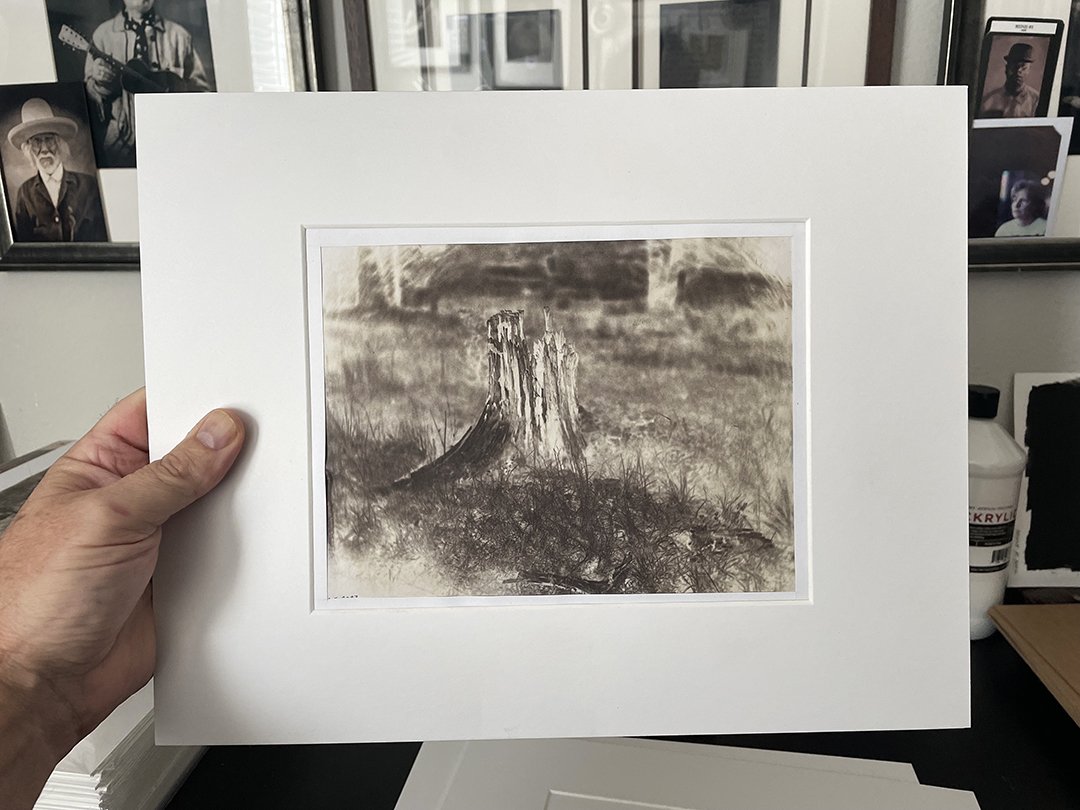The Creative Mind & Mortality: Artists & Anxiety: The RA-4 Color Reversal Direct Positive Process
Greetings!
If you can, join Quinn on Saturday, October 19, 2024, at 1000 MST for a conversation about the RA-4 color reversal direct positive process. This is a process where you expose color paper directly in the camera and process it as black and white and then color.
Quinn will talk about why he uses the process in his latest work, how the process works, and an overview of how to do it.
He'll talk about the "yellow and red problem with collodion" and how you can control the color in the reversal process.
It should be an interesting conversation. Remember, you can always watch it later on his YouTube channel if you can't make the live show.
Stream Yard: https://streamyard.com/u7j2qbsnh5
YouTube: https://www.youtube.com/live/U914Syb5UEY?si=48s2SQXQcrVfbG-P
“Stumped,” Whole Plate Calotype (paper negative) - 2023.
The Creative Mind & Mortality (Artists & Anxiety): Show and Tell
Greetings,
This week we’re going to have an hour of “show and tell.” Tim Layton, from Tim Layton Photography, is going to join us and share some of his work with calotypes (paper negatives) and the projects he’s working on in service of his existential struggles. (https://timlaytonfineart.com)
In what ways do the ephemeral qualities of calotypes (paper negatives) symbolize the human confrontation with mortality and the passage of time?
The paper in paper negatives is like the human body—fragile and temporary, yet it holds the impression of a moment in time, much like our lives carry fleeting memories before they fade, degrade, and decay with age.
Stream Yard: https://streamyard.com/h8xk5frc74
“Half Animal and Half Symbolic.” 24” x 9” RA-4 direct color photography and acrylic on paper.
Half Animal and Half Symbolic
Based on Becker's theories, I'm excited to share my latest artwork, "Half Animal and Half Symbolic." This is a unique blend of direct positive color photography and acrylic painting. Measuring 24" x 9". The image takes you on a visual journey through the contrast and harmony between representational and non-representational art—or biological and symbolic.
The left side features a photograph of a tattooed arm holding golden-yellow dead grass, highlighting intricate tattoos (look close) against a dark background. The right side is an abstract painting with dynamic textures and warm, vibrant tones that evoke movement and intensity. Inspired by themes of existential struggles (death anxiety and terror management theory) via Ernest Becker.
The photograph is a RA-4 Color Reversal Direct Positive print. The abstract painting is acrylic on paper. It's abstractly mimicking the tattoos in the painting. It's a bit of cubism and color theory mixed up in mortality.
“The essence of man is really his paradoxical nature, the fact that he is half animal and half symbolic.”
The Creative Mind & Mortality - Artists & Anxiety: The Rock Place and The Hard Place
Join Quinn this Saturday to explore "The Rock and The Hard Place" theory. Dr. Jeff Greenberg explained this theory as it applies to war and violence, but it's applicable to all human behavior and interaction. Listen in and find out where you stand: Are you in the 'rock place' or 'the hard place"? And what does that mean?
Art as a Coping Mechanism for Death Anxiety
Symbolic Immortality through Creation: Artists often seek to achieve a form of immortality through their works. How does the act of creating art function as an attempt to transcend death? You can examine artists who explicitly engage with mortality in their work—e.g., Damien Hirst’s exploration of death in his formaldehyde animal pieces or Renaissance artists’ depictions of death and resurrection themes. Let's see how this connects into the rock and the hard place theory.
Stream Yard: https://streamyard.com/4pxkphp6tx
“UFO and Dirt Tipis,” 6" x 6” (15 x 15 cm) wet collodion negative. This is a plate from “Ghost Dance,” the work I finished in 2019. I’ve decided I’m going to include some of this work in my new book. It’s all existential, and all fits really well together.
Do You Make Existential Art?
“UFO and Dirt Tipis,” 6" x 6” (15 x 15 cm) Collodio-Chloride print from the wet collodion negative above.
I think you do.
"Existential art" refers to a form of artistic expression that explores themes central to existentialism, a philosophical movement that focuses on the individual's experience, freedom, and responsibility in an often indifferent or absurd world. Existential art grapples with deep, universal questions about existence, existential anxiety, meaning, alienation, death, freedom, and the human condition (the denial of death). It typically emphasizes personal experience and the emotional and psychological struggle of confronting these fundamental existential issues.
There are some key characteristics of existential art; does your work fall into any of these areas? They include:
Confrontation with Death.
As death is a major concern in existential philosophy, existential art frequently explores death anxiety, the inevitability of death, and how it impacts the individual's sense of self and meaning in life. Death anxiety, the denial of death, and terror management theory are the basis for my work. This is what I lean on for context and motivation.
Themes of Absurdity and Meaninglessness.
Many existential works reflect a confrontation with the seeming lack of inherent meaning in life, a central theme in existentialism. This often leads to depictions of despair, absurdity, or the search for meaning in a chaotic world.
“We are like books. Most people only see our cover, the minority read only the introduction, many people believe the critics. Few will know our content.”
Freedom and Choice.
Existential art often examines the individual's freedom to make choices and the accompanying burden of responsibility. The freedom to define oneself and one's existence is juxtaposed with the anxiety or dread that this freedom can generate.
Alienation and Isolation.
Existential art frequently portrays feelings of alienation, isolation, and estrangement from society, other people, or even oneself. The individual’s search for authenticity and personal identity in a world that can feel impersonal or hostile is a recurring subject.
There are so many artists past and present working in this area. Too many to mention without leaving a lot out. However, a few that come to mind are Wassily Kandinsky, Mark Rothko, Paul Klee, and Edvard Munch. Munch’s famous painting The Scream expresses existential dread, or Alberto Giacometti, whose sculptures often reflect the isolation and vulnerability of the human figure.
“What the herd hates most is the one who thinks differently; it is not so much the opinion itself, but the audacity of wanting to think for themselves, something that they do not know how to do.”
Writers like Ernest Becker, Soren Kirkegaard, Martin Heidegger, Jean-Paul Sartre, Albert Camus, and Franz Kafka have explored existentialist themes in literature, and directors like Ingmar Bergman and Andrei Tarkovsky have used visual storytelling to explore existential issues in film.
The overarching goal of existential art is often to provoke the audience to reflect on their own existence and mortality and search for meaning in a world that may not offer easy answers.
I’m particularly interested in this because I’ve been making existential art for 35 years. It is a matter of perspective and narrative. If you haven’t read my advice on creating a body of work, check it out.
“I cannot pretend I am without fear. But my predominant feeling is one of gratitude. I have loved and been loved; I have been given much and I have given something in return; I have read and traveled and thought and written. I have had an intercourse with the world, the special intercourse of writers and readers. Above all, I have been a sentient being, a thinking animal, on this beautiful planet, and that in itself has been an enormous privilege and adventure.”
Background image: SPC 4 Quinn Jacobson (aka Jake) locks in on a target 175 meters downrange with an M203 grenade launcher mounted on an M16 rifle.
The Studio Q Show LIVE! September 21, 2024 at 1000 MST
Greetings!
I hope you can join me on Saturday for a conversation about war and violence in our culture. This is episode six of Conversations with Solomon.
Some questions to ponder after watching the video:
What aspects of the video did you find the most engaging or thought-provoking?
Do you believe that war and violence are inevitable aspects of human existence?
If you agree, what reasons support this belief?
How might the themes of violence and war in our culture be expressed or transformed into artistic creations?
Can you give any examples of artists using war and violence as a topic in their art?
I wanted to have this conversation a couple of weeks ago. It's so timely; I think we should look at the idea of war and violence as a jumping-off point for creating art. This is a topic that hits close to home for me. For those that have served in the military, these ideas can alleviate some of the trauma and stress from serving. I'll share some personal insight (my military time) and how Becker had a similar experience in the Army after WW2 liberating the death camps of Europe. Ernest Becker served in the infantry as well.
If you can, spend some time with this; take some notes and wrestle with the questions I asked (above) or your own. It's 40 minutes long, but worth every minute.
Conversations With Solomon: War and Violence
The links to the show on Saturday:
Stream Yard: https://streamyard.com/tvn88jifd2
You Tube: https://www.youtube.com/live/AG2mKG-VrP0?si=Rar2IUvz-shViVLW
I hope you have a wonderful week, and I hope to see you Saturday!
Addressing My Existential Concerns
I feel pretty good about this one. At least I don’t hate it. For me, it’s got some interesting marks, colors, and textures. It feels like a piece I would paint.
If you watch the video, you’ll get an idea of the textures and some of the “decay” coloring. It was a lot of fun making this painting. I’ll keep making marks and spilling paint!
The Creative Mind and Mortality (Artists & Anxiety): Writing An Artist's Statement
Join Quinn on Saturday, September 14, 2024, at 1000 MST for a talk about writing an artist statement. We'll address questions like:
What's the purpose of a statement?
Do I need one?
What should it contain?
What should I NEVER talk about in a statement?
Bring yours to share!
Stream Yard: https://streamyard.com/m83k3a75aq
You Tube: https://www.youtube.com/live/2I7TOJozYuY?si=lMtnK83V7qX0JK3Z
The Studio Q Show LIVE! September 7, 2024 at 1000 MST
Join Quinn on Saturday for a talk about the Ernest Becker Foundation's paper called, "Death Anxiety and Social Change." This paper explains how to approach these ideas both in your work and talking with other people about how death anxiety influences our day-to-day lives.
Stream Yard: https://streamyard.com/qw7aq7725j
You Tube: https://www.youtube.com/live/xrrVChZd-Nc?si=CedDtlW_xp8tdgw3











